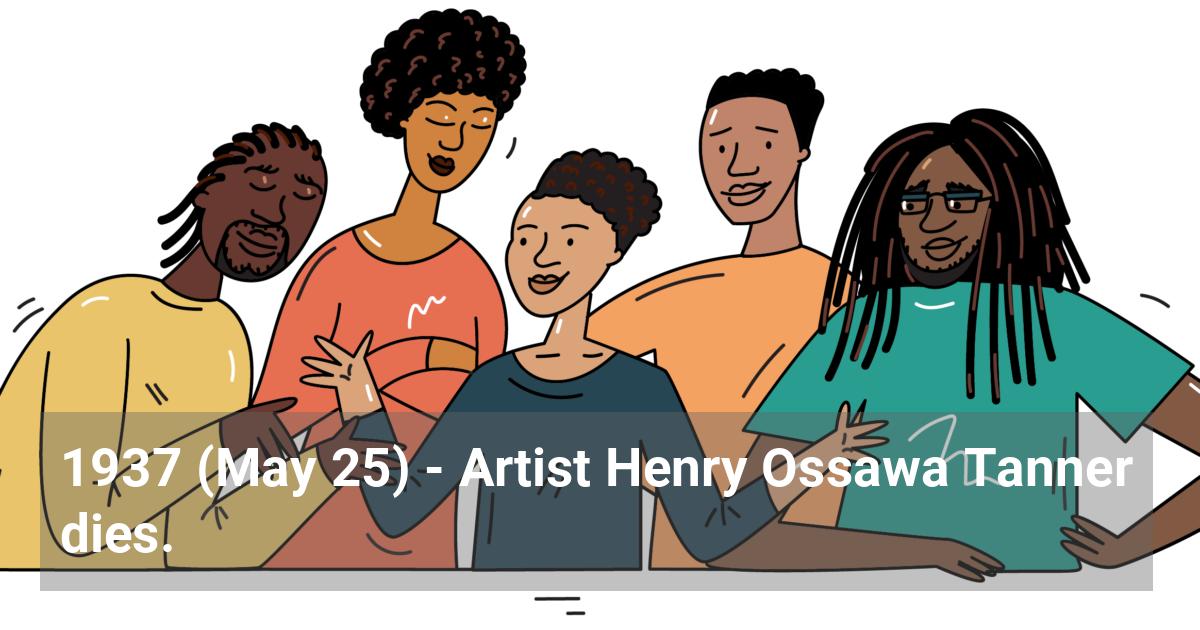Home / Full timeline / Artist Henry Ossawa Tanner dies.
 Artist Henry Ossawa Tanner dies.
Artist Henry Ossawa Tanner dies.
1937 (May 25)
Black American artist Henry Ossawa Tanner died. Thirty-two years later, the Frederick Douglass Institute and the National Collection of Fine Arts co-sponsored the first American exhibition of Tanner's work. Opening in Washington, D.C., at the National Collection of Fine Arts, the ninety-piece exhibit traveled to seven American museums. Only a handful of Black artists preceded Tanner, and this exhibit was the first one-man show by a Black artist to tour the country's major museums. The first of seven children born to Sarah Miller Tanner and Benjamin Tucker Tanner, a minister in the African Methodist Episcopal Church, he was raised in Philadelphia. At about the age of twelve Tanner saw a landscape painter at work in Fairmount Park in Philadelphia; he later wrote, “It set me on fire." Borrowing fifteen cents from his mother to buy supplies, he assiduously applied himself until the Pennsylvania Academy of Fine Arts in Philadelphia accepted him in 1880, when he was twenty-one. There, he studied with Thomas Eakins, the celebrated realist who taught him to manipulate light and shadow to express mood. An artist who depicted Black Americans as individuals, not caricatures, Eakins proved to be an important role model for Tanner. However, Tanner had trouble establishing his career in the states. In 1891, he set off for Paris to enroll in the Academie Julien, where he felt his success would not be inhibited by his race. However, his first entry in the Parisian Salon, The Bagpipe Lesson, was unsuccessful. After contracting typhoid fever during his second year in France, Tanner returned to Philadelphia to convalesce, and he entered into what is generally called his Black genre period. Influenced by a French tradition established by Jean-Francois Millet, Tanner addressed Black American themes, often incorporating teaching themes. The Banjo Lesson, The Knitting Lesson, The Reading Lesson, and The Sewing Lesson were all produced during this period. In the summer of 1893 Tanner delivered a paper titled The American Negro in Art, before the World's Congress on Africa in conjunction with the World's Columbian Exposition in Chicago. Although the text has been lost, Tanner's later autobiography, The World at Work (1909), expressed his views on Black genre painting. His genre period concluded the following year with The Thankful Poor. The work was lost for years but was rediscovered in 1970 and then exhibited for eleven years at the Philadelphia Museum of Art. Actor Bill Cosby and his wife purchased the piece in 1981 for $250,000. Biblical themes dominated the rest of Tanner's professional life, which he spent primarily in his adoptive French home. His Daniel In The Lion's Den piece received an honorable mention from the Salon in 1896, and The Raising of Lazarus was awarded a medal at the 1897 exhibition. Purchased by the French government for the Luxembourg Gallery, the painting joined the tableaux of John Singer Sargent and James A. McNeil Whistler, the only other American artists whose works had been purchased by the French government. In 1923, the French government further honored the artist, electing him a Chevalier of the Legion of Honor. Tanner, whose Pittsburgh homesite was designated a historical landmark by the Department of Interior in 1976, was the first Black to be elected to the National Academy of Design. In 1991, the Philadelphia Museum of Art sponsored a major retrospective containing more than one hundred Tanner paintings, drawings, photographs, and memorabilia.
References:
- • Hornsby, Alton. Chronology of African-American History: Significant Events and People from 1619 to the Present. Detroit: Gale Research, 1995.
